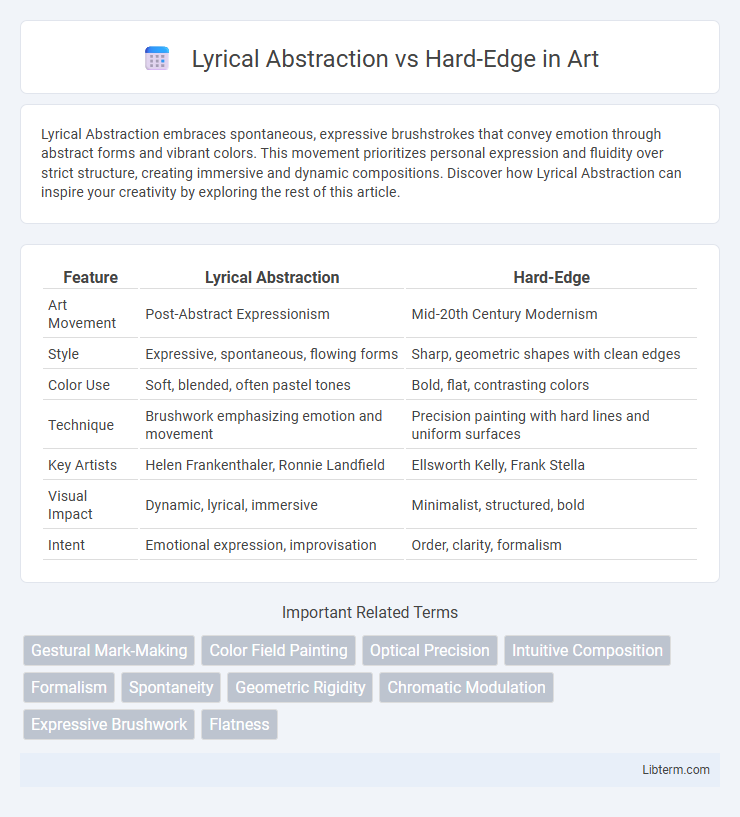Lyrical Abstraction embraces spontaneous, expressive brushstrokes that convey emotion through abstract forms and vibrant colors. This movement prioritizes personal expression and fluidity over strict structure, creating immersive and dynamic compositions. Discover how Lyrical Abstraction can inspire your creativity by exploring the rest of this article.
Table of Comparison
| Feature | Lyrical Abstraction | Hard-Edge |
|---|---|---|
| Art Movement | Post-Abstract Expressionism | Mid-20th Century Modernism |
| Style | Expressive, spontaneous, flowing forms | Sharp, geometric shapes with clean edges |
| Color Use | Soft, blended, often pastel tones | Bold, flat, contrasting colors |
| Technique | Brushwork emphasizing emotion and movement | Precision painting with hard lines and uniform surfaces |
| Key Artists | Helen Frankenthaler, Ronnie Landfield | Ellsworth Kelly, Frank Stella |
| Visual Impact | Dynamic, lyrical, immersive | Minimalist, structured, bold |
| Intent | Emotional expression, improvisation | Order, clarity, formalism |
Introduction to Lyrical Abstraction and Hard-Edge
Lyrical Abstraction emphasizes spontaneous, expressive brushwork and emotional intensity, emerging as a response to the rigidity of earlier abstract styles. Hard-Edge painting features sharp, clean lines and solid colors, focusing on geometric precision and visual clarity. Both movements highlight contrasting approaches to abstraction, with Lyrical Abstraction prioritizing fluidity and Hard-Edge foregrounding structure.
Historical Origins and Development
Lyrical Abstraction emerged in the late 1960s as a response to the rigid, geometric forms of Hard-Edge painting, emphasizing spontaneous, expressive brushwork and emotional intensity rooted in Abstract Expressionism. Hard-Edge, developed in the 1950s and early 1960s, is characterized by precise, clean lines and flat colors, reflecting a move toward formalism and clarity influenced by Minimalism and Color Field painting. The historical development of these movements highlights a shift from structured abstraction to a freer, more gestural approach within the post-war American art scene.
Key Artists and Influential Figures
Lyrical Abstraction features key artists such as Helen Frankenthaler, Sam Francis, and Ronnie Landfield, who emphasized expressive brushwork and fluid forms, contrasting sharply with Hard-Edge painters like Ellsworth Kelly, Frank Stella, and Karl Benjamin, known for their precise, geometric shapes and flat color fields. Frankenthaler's pioneering soak-stain technique influenced the lyrical movement's emphasis on spontaneity and emotional expression, while Stella's shaped canvases and rigorous compositions defined Hard-Edge abstraction's clarity and structural rigor. Both movements significantly shaped postwar American art, advancing divergent approaches to abstraction through their distinctive styles and philosophies.
Core Philosophies and Aesthetic Principles
Lyrical Abstraction emphasizes spontaneity, emotional expression, and fluid, organic forms, prioritizing the artist's intuitive process and dynamic gestures. Hard-Edge painting adopts precise, sharply defined geometric shapes and flat, uniform color areas, focusing on clarity, order, and an impersonal aesthetic. These core philosophies contrast emotional immediacy with controlled structure, reflecting divergent approaches to form and meaning within abstract art.
Techniques and Materials Used
Lyrical Abstraction employs gestural brushstrokes, fluid color washes, and spontaneous paint applications on canvas or paper, emphasizing texture and emotional expression through acrylics and oils. Hard-Edge painting uses precise, clean lines and solid color fields, often achieved with masking tape and airbrushes on smooth surfaces like canvas or Masonite. The contrast in materials and tools highlights Lyrical Abstraction's organic, tactile approach versus Hard-Edge's sharp, controlled geometric precision.
Visual Characteristics and Styles
Lyrical Abstraction emphasizes fluid, expressive brushstrokes and vibrant color fields, creating a sense of spontaneity and emotional depth, often with irregular, organic shapes. Hard-Edge painting, in contrast, features precise, clean lines and geometric forms with flat, uniform colors, promoting clarity and objectivity in composition. The visual style of Lyrical Abstraction is dynamic and freeform, while Hard-Edge art adheres to sharp, controlled boundaries and minimalistic color palettes.
Emotional Expression vs. Precision
Lyrical Abstraction emphasizes emotional expression through fluid, gestural brushstrokes and spontaneous compositions, conveying personal and poetic intensity. Hard-Edge painting prioritizes precision, featuring sharp lines, solid colors, and geometric forms that create a controlled, impersonal aesthetic. The contrast between these styles highlights a fundamental divide between expressive freedom and calculated clarity in abstract art.
Impact on Contemporary Art
Lyrical Abstraction's emphasis on gestural, spontaneous expression transformed contemporary art by reintroducing emotional depth and fluidity, contrasting with Hard-Edge's precise, geometric forms that reinforced minimalism and conceptual clarity. These movements collectively expanded the visual language of abstraction, influencing diverse practices from color field painting to contemporary graphic design. Their distinct approaches reshaped artists' ways of engaging with space, color, and form in modern artistic discourse.
Critical Reception and Legacy
Lyrical Abstraction received acclaim for its emotive brushwork and expressive use of color, embodying a free-form, spontaneous approach that contrasted sharply with the calculated precision and geometric rigor of Hard-Edge painting. Critics often praised Lyrical Abstraction for revitalizing personal expression in modern art, while Hard-Edge faced mixed reviews due to its perceived austerity but gained respect for its contribution to the evolution of minimalism and color field painting. The legacy of Lyrical Abstraction influenced subsequent generations of abstract expressionists, whereas Hard-Edge left a lasting impact on design principles and the development of contemporary abstract art movements.
Conclusion: Comparing Lasting Significance
Lyrical Abstraction's emphasis on emotion and spontaneity fostered a profound influence on abstract expressionism's evolution, maintaining relevance in contemporary art through its fluid forms and vibrant palettes. Hard-Edge's precision and clarity contributed significantly to minimalist and geometric abstraction movements, establishing a lasting legacy in design and visual culture with its crisp, defined shapes. Both movements have enduring significance, with Lyrical Abstraction inspiring emotional depth and Hard-Edge promoting structural clarity in modern and postmodern artistic practices.
Lyrical Abstraction Infographic

 libterm.com
libterm.com